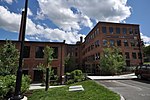Five Corners Historic District
Historic districts in Berkshire County, MassachusettsHistoric districts on the National Register of Historic Places in MassachusettsNRHP infobox with nocatNational Register of Historic Places in Berkshire County, MassachusettsUse mdy dates from August 2023 ... and 1 more
Williamstown, Massachusetts

The Five Corners Historic District is a historic district encompassing the central district of the village of South Williamstown, Massachusetts. It is centered at the junction of Cold Spring, Green River, New Ashford. The junction has been a prominent center in the area since 1760. Prominent buildings in the district include the South Center School, the Store at Five Corners, and the Second Congregational Church. The district was listed on the National Register of Historic Places in 1993.
Excerpt from the Wikipedia article Five Corners Historic District (License: CC BY-SA 3.0, Authors, Images).Five Corners Historic District
New Ashford Road,
Geographical coordinates (GPS) Address Phone number Website Nearby Places Show on map
Geographical coordinates (GPS)
| Latitude | Longitude |
|---|---|
| N 42.659722222222 ° | E -73.2425 ° |
Address
Waubeeka Golf Links
New Ashford Road
12345
Massachusetts, United States
Open on Google Maps








